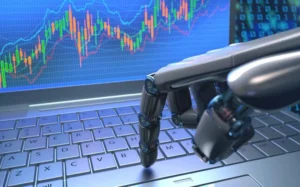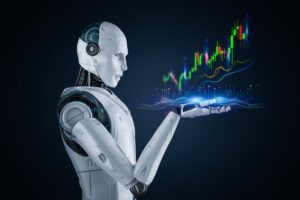How to use AI for Stock Trading


Utilizing AI for Trading: A Game-Changing Strategy
How to use AI for Stock Trading In the ever-shifting landscape of financial markets, securing a competitive edge is more critical than ever. Traders, from seasoned professionals to newcomers, are constantly in search of innovative tools and strategies to outperform the competition. One such revolutionary approach is harnessing the potential of artificial intelligence (AI) for trading. In this comprehensive guide, we will delve deep into AI-powered trading strategies and explore how you can leverage this technology to transform your trading portfolio. This article is designed to provide an in-depth understanding of “how to use AI for trading.”
Understanding AI in Trading (How to use AI for Stock Trading)
What is AI, and how does it fit into trading?
Artificial intelligence, commonly referred to as AI, is a subfield of computer science dedicated to creating systems capable of performing tasks that typically require human intelligence. In the realm of trading, AI plays a pivotal role in analyzing vast amounts of data, making predictions, and executing trades with precision. Understanding the fundamental concepts of AI is essential in the context of utilizing AI for trading.
AI is like having a team of highly skilled analysts constantly monitoring the markets, making predictions, and executing trades—all without fatigue or emotion. The keyword “how to use AI for trading” is embedded in this concept as we explore how AI can serve as a powerful ally for traders.
The Advantages of AI in Trading (How to use AI for Stock Trading)


- Data Analysis: AI possesses the unparalleled ability to process massive data volumes swiftly and with pinpoint accuracy. This capability allows AI to identify trading opportunities and patterns that might elude human traders.
- Risk Management: AI algorithms excel in real-time risk assessment and can adjust trading strategies promptly to mitigate potential losses. The integration of AI enhances the security of your trading endeavors.
- Emotion-Free Trading: Unlike human traders, AI remains immune to emotional fluctuations. It doesn’t experience fear or greed, emotions that often lead to irrational trading decisions. This aspect of AI is especially pertinent when discussing “how to use AI for trading.”
- Continuous Vigilance: AI operates around the clock, monitoring market conditions and executing trades without the need for breaks or rest. It ensures that you never miss a trading opportunity, which is essential when considering “how to use AI for trading.”
- Back testing: AI can rigorously analyze historical data to fine-tune and optimize trading strategies. It serves as an invaluable tool for traders seeking to improve their performance through meticulous analysis.
AI in trading is not merely a buzzword; it’s a transformative force that can significantly elevate your trading game. The keyword “how to use AI for trading” is implicit in these advantages, as they underscore how AI can revolutionize your trading strategies.
Implementing AI in Your Trading Strategy
Selecting the Right AI Tools
To harness the power of AI in trading, you need the right tools and technologies. A variety of AI-driven trading platforms are available, each with its own unique strengths and weaknesses. The key to effectively using AI for trading lies in selecting a platform that aligns with your specific trading goals and preferences.
Choosing the appropriate AI tools is akin to selecting the right instruments for a musical performance. The tools you select will influence the quality of your trading decisions, and this is a vital consideration when exploring “how to use AI for trading.”
Data Collection and Analysis


AI’s effectiveness in trading hinges on the quality and quantity of data it processes. Ensure that you have access to real-time market data, news updates, and other pertinent information. High-quality data sources are the lifeblood of your AI trading system, ensuring that it can make precise and timely predictions.
Data is the foundation of AI-powered trading. The more high-quality data you have, the better your AI system can perform. Thus, data collection and analysis are integral to mastering “how to use AI for trading.”
Developing AI-Based Trading Models
How to use AI for Stock Trading Creating an AI-based trading model involves defining trading rules, setting risk parameters, and optimizing the system for the desired level of performance. This process may necessitate the expertise of data scientists, AI developers, and financial analysts. The development of AI-based trading models is a pivotal aspect when exploring “how to use AI for trading.”
Think of AI-based trading models as your personal orchestra conductor, directing each instrument (trading rule) to produce harmonious and profitable results. This analogy underscores the complexity and precision involved in implementing “how to use AI for trading.”
Continuous Monitoring and Optimization
How to use AI for Stock Trading AI systems are not static; they require ongoing monitoring and fine-tuning to adapt to changing market conditions and enhance performance. This is an often-underestimated aspect of “how to use AI for trading.” Regularly evaluating and optimizing your AI trading model is essential to staying ahead in the dynamic world of financial markets.
Think of AI as a dynamic organism that evolves with the market. Without continuous monitoring and optimization, it may lose its edge. This aspect emphasizes the iterative nature of implementing “how to use AI for trading.”
Real-World Examples of AI-Enhanced Trading (How to use AI for Stock Trading)


Algorithmic Trading
Algorithmic trading, often referred to as algo-trading, relies heavily on AI and machine learning. These systems can process market data swiftly and execute trades at lightning speed. Algorithmic trading is a prominent example of “how to use AI for trading.”
Sentiment Analysis
How to use AI for Stock Trading AI can analyze market sentiment derived from sources such as social media, news articles, and financial reports. This sentiment analysis can provide valuable insights into market trends and help traders adjust their strategies accordingly. It offers a practical application of “how to use AI for trading.”
Portfolio Optimization
AI can assist traders in diversifying their portfolios effectively by identifying the right mix of assets based on historical data and prevailing market conditions. How to use AI for Stock Trading Portfolio optimization is an essential component of mastering “how to use AI for trading.”
The Future of AI in Trading
The field of AI in trading is continually evolving, with exciting developments on the horizon. As


How to use AI for Stock Trading As technology advances and AI algorithms become more sophisticated, traders can anticipate even more powerful tools at their disposal. Some future developments to look out for include:
- Quantum Computing: Quantum computing has the potential to revolutionize AI in trading by significantly increasing processing power and data analysis capabilities. This represents a quantum leap in “how to use AI for trading.”
- Explainable AI: As AI systems become more complex, there is a growing need for transparency in decision-making. Explainable AI aims to make AI decisions more understandable for traders, simplifying “how to use AI for trading.”
- AI-Driven Trading Platforms: The emergence of more user-friendly AI trading platforms designed to cater to a broader audience is a step forward in democratizing “how to use AI for trading.”
- Integration with Blockchain: Combining AI with blockchain technology can enhance security and transparency in trading, opening up new possibilities for traders and expanding the horizons of “how to use AI for trading.”
In conclusion, the integration of AI into trading strategies is not only a practical choice but an increasingly necessary one in today’s fast-paced financial markets. The advantages of data analysis, risk management, and emotion-free trading are undeniable, and they form the bedrock of “how to use AI for trading.” However, it’s essential to choose the right AI tools, collect and analyze data effectively, and develop and continually optimize trading models for success.
As AI in trading continues to evolve, it promises to provide traders with more sophisticated tools and deeper insights into the financial markets. By staying informed and embracing these advancements, you can position yourself at the forefront of the trading world, fully understanding “how to use AI for trading” to your advantage.
